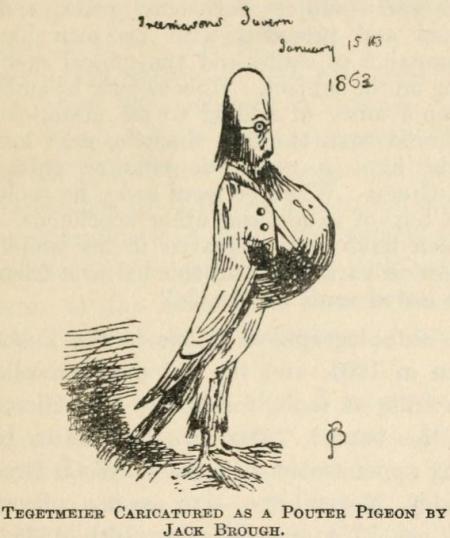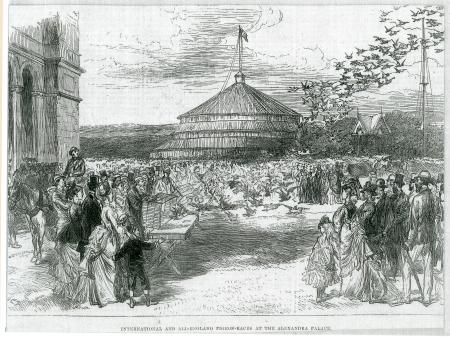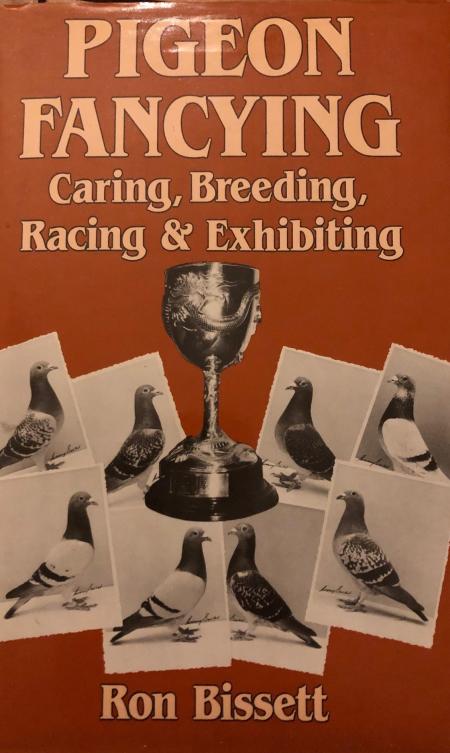Love them or hate them, pigeons are around us every day. We may have very polarised standpoints on this one breed of bird for many reasons, but they have had a lot of important uses over the centuries. Take a look at this round-up of Haringey's surprising links with all things pigeons!
This little painting (below) by Inga Bystram shows her love of pigeons. She has captured their characters in her artwork, as they nestle on the balconies near her home on the Broadwater Farm estate:

Here’s someone else who loved pigeons. He has been characterised in the cartoon drawing below – as a pigeon!

The person caricatured above is William Bernhardt Tegetmeier F.Z.S. (1816 – 1912) who lived with his family at 101 St James’ Lane in Muswell Hill, between 1858 and 1868. His house still stands today. It would appear that the Tegetmeier family had also earlier associations in the Haringey area, having lived in Tottenham in 1852 where their son was born. In 5 September 2008, a Haringey Historical Green Plaque was unveiled in his
honour at his former home in Muswell Hill.
The suggestion to commemorate Tegetmeier with a plaque within the scheme was the initiative of local historians Ken Gay and Keith Fawkes-Underwood of Hornsey Historical Society (HHS). We learn in the HHS Bulletin 34 (1993) that despite the best efforts of the society, they had not been able to secure an English Heritage Blue Plaque for him on this site. But who was Tegetmeier and what had he done?
Tegetmeier was a writer and journalist of domestic science and a naturalist. His love and study of pigeons also extended to studying poultry and bees. He was a published authority on poultry and, as a beekeeper, he discovered how bees created the hexagon shaped cells in their hives. He was also a racing pigeon pioneer. But it was his correspondence and friendship with Charles Darwin about his work and research on poultry and bees that was influential and valuable in developing Darwin’s ideas on evolution, for his seminal work “On the Origin of Species”.

Whilst someone like Darwin may be a colossus in the field of science, through our Haringey plaque scheme we were able to bring public attention to one of the many other ‘heroes of science’ whose contribution is sometimes overlooked, hidden or forgotten (and we have a few of these in Haringey). Members of the Tegetmeier family travelled from far and wide to attend, as well as representatives of the Zoological Society (as Tegetmeier was a Fellow) and members of the North London Beekeepers group (Tegetmeier was the Founder and President of the Apiarian Society – all about bee-keeping). Sadly, David Attenborough was not able to attend as he was filming in the Antarctic – but we had a wonderful letter from him which was read out on the day of the plaque unveiling.
Tegetmeier himself had been (justifiably) proud of the research assistance he had given to Darwin. But if it hadn’t been for his love of pigeons, then Tegetmeier might not ever have met Darwin. In 1855, he was introduced at a meeting of the Philoperisteron Society to someone who had begun an interest in pigeons. Tegetmeier described the encounter in an article:
“Continuing my love for pigeons, I became the secretary of the most exclusive pigeon association, the Philoperisteron Society, which held its annual meetings in the great hall of the Freemasons’ Tavern. At one of these exhibitions I heard a voice which said, ‘Oh, here’s Tegetmeier; he will tell you all about these birds better than I can’. I turned round, and saw [my friend William] Yarrell with a stranger, whom he introduced as Mr. Darwin.”
Despite his admiration for Darwin it appears that Tegetmeier had actually misremembered where he first encountered his new friend. Their letters and diaries suggest they met elsewhere, at the Anerley Show in August 1855. Nonetheless, however they met, it sparked a friendship which lasted 27 years until Darwin’s death. You can see many of the letters they wrote to one another whilst Tegetmeier lived in Muswell Hill in the online Darwin Correspondence Project at Cambridge University.
Here is one letter from Darwin written in 1865, and an example of another letter from Tegetmeier written in 1866. The letter (transcribed below) from Darwin about the publication of his new work, was kept by Tegetmeier inside his presentation copy of the first edition of On the Origin of Species. Darwin wrote to Tegetmeier on 9th April 1859:
“I shall go next month to press with an abstract of my general views on the origin of species, & it will make a volume of about 500 pages, & I shall have much pleasure in sending you a copy when it is published.— I shall give abstract of conclusions at which I have arrived on Bees cells.— Believe me with many thanks Yours very sincerely C. Darwin"
Tegetmeier had a long writing career, with many of his most notable publications published whilst he lived in St James’ Lane. In 1858 he had success with A Manual of Domestic Economy, which ran into 14 editions. Other subsequent books were Bees, Hives and Honey (1865), The Poultry Book (1867) and Pigeons: Their Structure, Varieties, Habits, and Management.
Tegetmeier was also a pioneer of pigeon racing. He organised the first international pigeon race in 1871, and carried on organising pigeon races from Alexandra Palace, beginning in 1875. Below is an illustration which shows one of those events at Alexandra Palace – clearly extremely popular judging by the crowds, and attracting a range of people including families.

Local enthusiasm for pigeon racing did not end when Tegetmeier died in 1912. Later in the 20th century, other experts from the borough were organising such races.

The author of the book above – Ron Bissett – lived in Harringay Road in West Green. According to notes left to us by our friend Ray Swain, Ron had once been the Secretary as well as ‘clock-setter’ for the races of his local West Green Homing Society and had also become the Life Vice-President of the Alexandra Palace Homing Society, one of the oldest established pigeon racing clubs in London. A pigeon fancier of over 50 years, he was also for 35 years (when he wrote the book above in 1985) the Assistant Editor of the Racing Pigeon Weekly, a specialist newspaper that had been founded in 1898. From 1965 – 1979, Ron was Team Manager of the Royal Pigeon Racing Association, caring for the Great Britain team of birds entered into the International Pigeon Olympiad. The 1965 Olympiad and Congress was staged at Alexandra Palace, working with his colleague on the Racing Pigeon Weekly, Colin Osman.
In a literary memoir about pigeon fancying published last year, Homing: On Pigeons, Dwellings and Why We Return, by Jon Day, one character says to Day:
“You never really own a pigeon …whenever you let them loose to exercise or race, they are free to leave. The challenge is creating a home they want to return to.”
Maybe we can all ask ourselves the question - what can we learn from a pigeon about our idea of home?